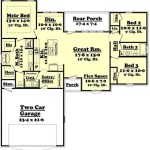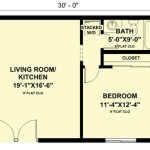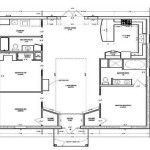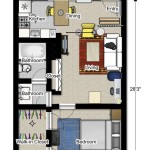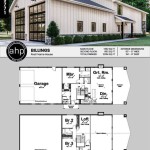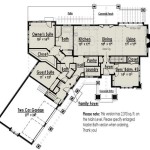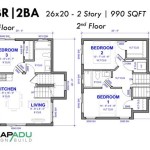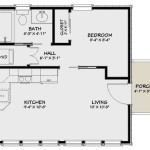3-Bedroom House Design: Optimizing Space and Functionality with Floor Plans
The design and construction of a 3-bedroom house represents a common and practical solution for families, couples requiring extra space, or individuals desiring room for guests and hobbies. The appeal of this house configuration lies in its versatility, offering a balance between affordability, manageability, and spaciousness. A well-designed 3-bedroom house prioritizes functionality and aesthetic appeal, maximizing the available square footage to create a comfortable and efficient living environment. A critical element in achieving this is the careful consideration and execution of the floor plan, which dictates the organization and flow of the interior spaces.
This article will explore key aspects of 3-bedroom house design, with a particular focus on the floor plan. We will delve into various floor plan layouts, considerations for optimizing space, the integration of different architectural styles, and the importance of adhering to building codes and regulations. The goal is to provide a comprehensive understanding of how to approach the design of a 3-bedroom house to achieve a functional, aesthetically pleasing, and sustainable living space.
Understanding the Importance of a Well-Designed Floor Plan
The floor plan serves as the blueprint for the entire house. It outlines the arrangement of rooms, the size and shape of each space, and the connections between them. A poorly designed floor plan can lead to several issues, including inefficient use of space, awkward traffic flow, lack of privacy, and difficulties in furniture placement. Conversely, a well-designed floor plan can enhance the livability of the house, improve its functionality, and even increase its perceived value.
Key considerations for a successful floor plan include the lifestyle of the occupants. For example, a family with young children might prioritize a large, open-plan living area for easy supervision, while a couple who frequently entertains might prefer a formal dining room and a well-equipped kitchen. The floor plan should also take into account the orientation of the house on the lot, maximizing natural light and ventilation while minimizing exposure to harsh sunlight or strong winds. Furthermore, the floor plan must comply with all relevant building codes and regulations related to safety, accessibility, and energy efficiency.
Several types of floor plans are commonly used for 3-bedroom houses, each with its own advantages and disadvantages. Ranch-style houses, for example, typically feature a single-story layout with all rooms on the same level. This design is ideal for individuals with mobility issues or those who prefer a low-maintenance lifestyle. Two-story houses, on the other hand, offer more living space on a smaller footprint, making them a good choice for urban areas or smaller lots. Split-level houses provide a unique layout with different areas of the house on slightly different levels, creating visual interest and separation of spaces. Ultimately, the best floor plan for a 3-bedroom house will depend on the specific needs and preferences of the homeowner, as well as the characteristics of the site and the surrounding environment.
Key Considerations in 3-Bedroom House Design
Designing a 3-bedroom house involves navigating a multitude of factors, from spatial planning to material selection. Beyond the fundamental floor plan, several key considerations influence the overall functionality and aesthetic appeal of the design. These factors are crucial in creating a home that effectively meets the needs and desires of its inhabitants.
Space Optimization: Maximizing the utilization of available space is paramount, particularly in smaller 3-bedroom houses. This can be achieved through careful planning of room sizes and layouts. Open-concept living areas, combining the living room, dining room, and kitchen, can create a sense of spaciousness and improve traffic flow. Incorporating built-in storage solutions, such as shelving, cabinets, and closets, can help to declutter the house and free up valuable floor space. Multi-functional furniture, such as sofa beds or storage ottomans, can also be used to optimize space in smaller bedrooms or living areas.
Bedroom Placement and Privacy: The placement of bedrooms within the floor plan should prioritize privacy and noise reduction. Ideally, the master bedroom should be located away from the other bedrooms, perhaps at the opposite end of the house. Creating buffer zones, such as hallways or bathrooms, between bedrooms can help to minimize noise transmission. The orientation of bedrooms should also be considered, taking into account factors such as sunlight exposure and views. South-facing bedrooms may benefit from more natural light, while east-facing bedrooms may be ideal for those who prefer to wake up with the morning sun.
Bathroom Configuration: The number and layout of bathrooms in a 3-bedroom house are critical considerations. A master bathroom, directly accessible from the master bedroom, is a common feature in many designs. A shared bathroom, accessible from the hallway or the other bedrooms, is also typically included. The layout of the bathrooms should be functional and efficient, with adequate space for all necessary fixtures and amenities. Consider incorporating features such as double sinks, separate showers and tubs, and ample countertop space to enhance the usability of the bathrooms.
Kitchen Design and Functionality: The kitchen often serves as the heart of the home, and its design should reflect this importance. Consider the work triangle, which is the imaginary line connecting the sink, the refrigerator, and the stove, to ensure efficient workflow. Adequate countertop space is essential for food preparation. Storage solutions, such as cabinets, drawers, and pantries, should be ample and well-organized. Consider incorporating features such as a kitchen island or a breakfast bar to provide additional workspace and seating. Natural light and ventilation are also important considerations for kitchen design.
Living Areas and Circulation: The living areas, including the living room, dining room, and any additional family rooms, should be designed to promote comfortable living and social interaction. The flow of traffic between these areas should be smooth and intuitive. Consider incorporating features such as fireplaces, built-in entertainment centers, and large windows to enhance the aesthetic appeal of the living areas. Adequate lighting, both natural and artificial, is also essential.
Material Selection and Sustainability: The materials used in the construction and finishing of a 3-bedroom house can have a significant impact on its durability, energy efficiency, and aesthetic appeal. Choose materials that are durable, low-maintenance, and environmentally friendly. Consider incorporating sustainable design principles, such as using recycled materials, installing energy-efficient appliances, and maximizing natural light and ventilation. Paying attention to the environmental impact of material choices contributes to a more sustainable and responsible design.
Exploring Different 3-Bedroom House Floor Plan Layouts
The arrangement of rooms within a 3-bedroom house can vary significantly depending on the overall design style and the specific needs of the inhabitants. Several common floor plan layouts cater to different lifestyles and preferences. Each layout presents unique advantages and challenges in terms of space utilization, privacy, and functionality.
Ranch-Style Floor Plan: Ranch-style houses are characterized by their single-story layout, typically featuring a long, low profile. In a 3-bedroom ranch house, the bedrooms are often located along one side of the house, while the living areas are situated on the other. This layout provides easy accessibility and is ideal for individuals with mobility limitations. It also promotes a sense of openness and connection between the different rooms. However, ranch-style floor plans may require a larger lot size and can sometimes feel less private than multi-story layouts.
Two-Story Floor Plan: Two-story houses offer a compact footprint and efficient use of space. In a 3-bedroom two-story house, the bedrooms are typically located on the upper floor, while the living areas are on the ground floor. This arrangement provides a greater degree of privacy and separation between sleeping and living spaces. Two-story houses are well-suited for smaller lots and urban environments. However, they may require more stairs, which can be a concern for individuals with mobility issues or young children.
Split-Level Floor Plan: Split-level houses offer a unique take on the traditional two-story layout. They feature multiple levels that are offset from each other, creating a dynamic and visually interesting design. In a 3-bedroom split-level house, the bedrooms are typically located on one level, while the living areas are on another, and the entrance and garage are on a third. This layout provides a good balance of privacy and openness, and it can be well-suited for sloped lots. However, split-level floor plans can sometimes feel disjointed or confusing, and they may require more stairs than a traditional two-story house.
Open Concept Floor Plan: Regardless of the overall house style, an open concept floor plan integrates the living room, dining room, and kitchen into a single, unified space. This layout promotes a sense of spaciousness and allows for easy interaction between family members or guests. Open concept floor plans are popular in contemporary designs and are well-suited for casual lifestyles. However, they may offer less privacy and can be more challenging to heat and cool efficiently.
Considerations for Universal Design: Incorporating principles of universal design during the floor plan development ensures that the house is accessible and usable by people of all ages and abilities. This includes features such as wide doorways and hallways, level thresholds, grab bars in bathrooms, and adjustable-height countertops. Universal design can enhance the livability and resale value of the house, making it a wise investment for the future.
Ultimately, the choice of floor plan layout will depend on the specific needs and preferences of the homeowner, as well as the characteristics of the site and the surrounding environment. Careful consideration of these factors is essential to creating a functional, aesthetically pleasing, and sustainable 3-bedroom house.

3 Bedroom House Design 2024 Beautiful Plans Modern Bungalow Plan Gallery

Simple Yet Elegant 3 Bedroom House Design Shd 2024031 Duplex Plans Unique Three Plan

Check Out These 3 Bedroom House Plans Ideal For Modern Families

Low Budget Modern 3 Bedroom House Design 2d Plan

The Blue House Design With 3 Bedrooms Pinoy Plans

Simple 3 Room House Plan S 4 Nethouseplans Building Plans Designs With Bungalow Floor
Small House Design Ideas With Floor Plan 3 Bedroom Plans

3 Bedrooms Villa Plan 13 7x19m Samphoas Bungalow Style House Plans Home Design Floor

3 Bedroom House Plan With Swimming Pool H7

Elevated 3 Bedroom House Design Cool Concepts

